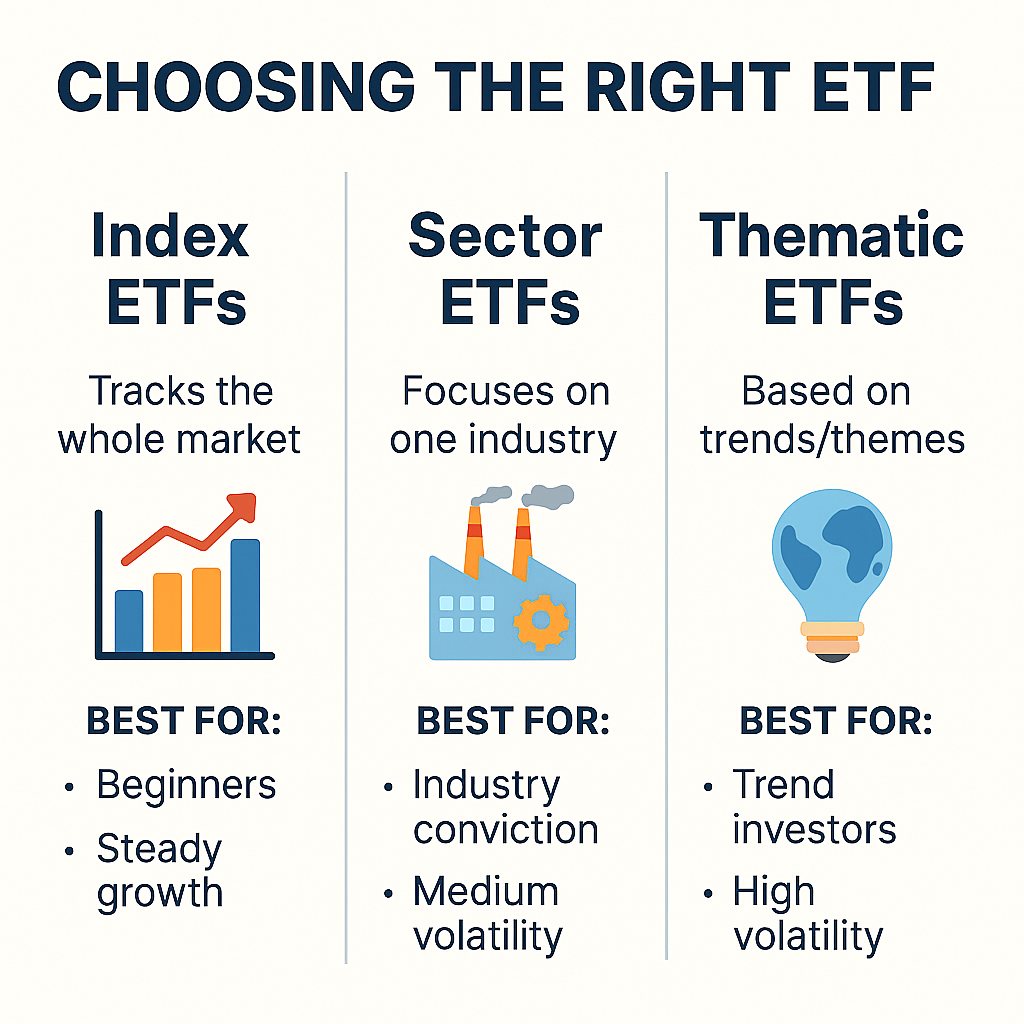If you’ve just started exploring ETFs, one of the first questions you might have is:
“There are so many ETFs… how do I choose the right one?”
In this beginner-friendly guide, we’ll break down three main ETF types — Index ETFs, Sector ETFs, and Thematic ETFs — and share practical tips to help you pick the one that fits your investing style.
📊 1. Index ETFs – The Most Basic and Stable Choice
What it is:
An Index ETF tracks a specific stock market index like the S&P 500, NASDAQ-100, or Russell 2000. It’s designed to mirror the performance of the entire market or a major market segment.
Examples:
- SPDR S&P 500 ETF (SPY) – Tracks 500 leading U.S. companies
- Invesco QQQ – Follows the NASDAQ-100 index
- Vanguard Total Stock Market ETF (VTI) – Covers almost the entire U.S. stock market
Best for:
- Investors who don’t want to pick individual stocks
- Those seeking steady, long-term growth
- Fans of Warren Buffett’s “buy the whole market” approach
💬 “I just want to bet on the growth of the entire market!”
👉 Go with an Index ETF.
🏭 2. Sector ETFs – For Targeting Specific Industries
What it is:
Sector ETFs focus on a particular industry, such as technology, healthcare, energy, or financials. They let you invest in a group of companies operating in the same field.
Examples:
- Technology Select Sector SPDR (XLK) – U.S. tech giants like Apple, Microsoft, and Nvidia
- Health Care Select Sector SPDR (XLV) – Pharmaceutical and biotech leaders
- Energy Select Sector SPDR (XLE) – Oil, gas, and energy companies
Best for:
- Investors confident in the future of a specific industry
- Those who want to align investments with market trends
- Investors willing to accept medium volatility for higher growth potential
💡 “I believe renewable energy will dominate the future!”
👉 Consider a Sector ETF targeting that industry.
🌈 3. Thematic ETFs – Riding the Hottest Trends
What it is:
Thematic ETFs are built around investment themes or stories rather than just market indexes or sectors. They often focus on innovative technologies, demographic shifts, or cultural trends.
Examples:
- iShares Global Clean Energy ETF (ICLN) – Renewable energy companies worldwide
- Global X Robotics & Artificial Intelligence ETF (BOTZ) – AI and robotics innovators
- Roundhill Ball Metaverse ETF (METV) – Companies building the metaverse
Best for:
- Trend-savvy investors who want to capture emerging opportunities
- Those looking for fun, story-driven investments
- Investors who can handle high volatility
⚠️ Thematic ETFs often have smaller, more concentrated holdings and can change rapidly. They’re better for trend plays rather than long-term stability.
📌 Quick Comparison
| Type | Main Feature | Risk Level | Best For |
|---|---|---|---|
| Index | Tracks the whole market | Low | Beginners, long-term investors |
| Sector | Focuses on one industry | Medium | Investors with industry conviction |
| Thematic | Based on trends/themes | High | Risk-tolerant trend investors |

📝 Final Tips for Beginners
- Start with an Index ETF for broad market exposure.
- Add Sector ETFs if you have strong beliefs about an industry’s growth.
- Use Thematic ETFs for smaller, high-risk/high-reward portions of your portfolio.
“For most people, investing in a low-cost S&P 500 index fund is the wisest choice.” – Warren Buffett
✅ If you’re new to investing, remember: ETF investing is not about finding the next big winner — it’s about building steady, diversified growth over time.
📝 Disclaimer
This article is intended for educational purposes only. It does not constitute financial, investment, or legal advice. All investment decisions involve risks, and readers should conduct their own research or consult with a licensed financial advisor.
